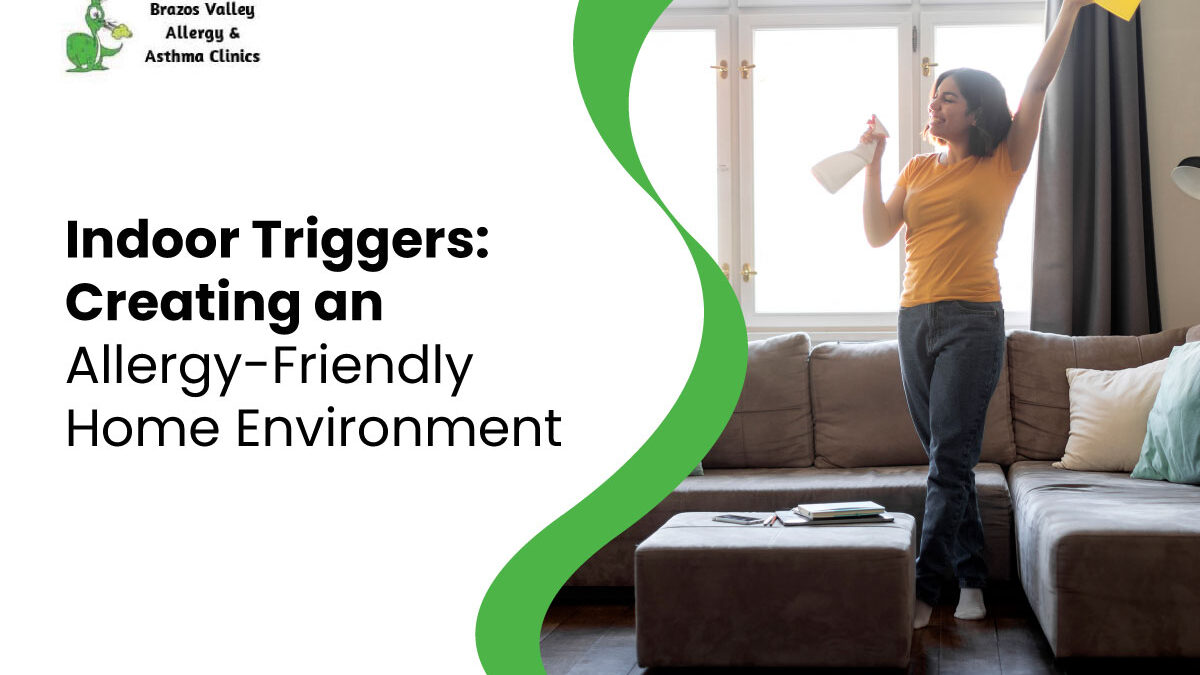- 979-485-9287
- office@bvallergy.com
-
 979-251-7804
979-251-7804
Indoor Triggers: Creating an Allergy-Friendly Home Environment

Asthma and Allergy Triggers to Avoid During Spring Season
May 31, 2023
Air Quality and Asthma: Managing Triggers During Summer Heatwaves
July 10, 2023If you have allergies, living in a safe and comfortable home environment is crucial for you. Various factors, such as dust mites, pet dander, mold, and pollen, can trigger allergies indoors. These triggers can cause discomfort and even severe allergic reactions that may lead to emergencies.
This article will explore effective strategies and practical tips to create an allergy-friendly home environment. By implementing these measures, you can minimize indoor triggers and ensure a healthier living space for you and your loved ones. If you want to know how to reduce allergies indoors, continue reading.
Understanding Indoor Allergy Triggers
Before we delve into creating an allergy-friendly home environment, we must understand the common indoor triggers that can cause allergies. Let’s explore some of these triggers below.
-
Dust Mites
These microscopic creatures thrive in warm and humid environments, such as bedding, upholstered furniture, and carpets. Their waste particles are a common trigger for indoor allergies. Studies from The National Institutes of Health stated that 5 to 30 percent of the general population have dust mite sensitivity.
-
Pet Dander
The proteins found in pet saliva, urine, and dead skin flakes can cause allergic reactions in sensitive individuals. Common pets like cats and dogs are often the culprits behind pet dander allergies. According to the Asthma and Allergy Foundation of America researchers, 10 to 20% of people worldwide have pet allergies.
-
Mold and Mildew
Areas with high moisture, such as comfort rooms, basements, and kitchens, are prone to mold and mildew growth. The spores released by these fungi can trigger allergies and respiratory issues. Fact check: 10% of people worldwide have allergies to mold and mildew. Data from the American College of Occupational and Environmental Medicine.
-
Pollen
While pollen is typically an outdoor allergen, it can find its way indoors through open windows, doors, and clothing. Individuals with pollen allergies may experience symptoms even within their homes. The Allergy and Asthma Foundation of America estimated that 80 million in the United States alone have allergic rhinitis. Air allergens are one of the most challenging triggers to avoid since they are virtually invisible.
Now that we covered indoor triggers let’s move on to practical steps you can take to create an allergy-friendly home environment.
How to Improve Indoor Air Quality in Your Home
Before making any changes, assessing your indoor environment to identify potential triggers is essential. This check will help you understand which areas require the most attention and where to focus your efforts. Here are some steps you can follow:
Step 1: Conduct a Comprehensive Cleaning
Begin by thoroughly cleaning your home. Dust surfaces, vacuum carpets and furniture, and mop hard floors. This initial cleaning will remove visible dust and allergens, providing a cleaner starting point for implementing further measures. Keeping your house clean provides indoor allergy relief.
Step 2: Check for Moisture and Mold
Inspect moisture-prone areas, such as bathrooms, kitchens, and basements. Look for signs of mold or mildew, such as discoloration, musty odors, or water stains. Address any issues promptly by fixing leaks, improving ventilation, or using dehumidifiers.
Step 3: Assess Ventilation
Evaluate the ventilation system in your home. Proper ventilation helps reduce moisture and improve indoor air quality. Ensure that vents and air filters are clean and in good working condition. Consider installing exhaust fans in high-moisture areas.
How to Create an Allergy-Friendly Bedroom
The bedroom is a crucial space for allergy sufferers as it is where they spend significant time. Below are some measures to make your bedroom more allergy-friendly.
Choosing the Right Bedding
- Invest in Allergen-Proof Mattress and Pillow Covers: These covers act as a barrier against dust mites and allergens, preventing them from entering your bedding.
- Wash Bedding Frequently: Wash your sheets, pillowcases, and blankets in hot water regularly to eliminate allergens. Use fragrance-free, hypoallergenic laundry detergents.
- Opt for Allergy-Friendly Pillows and Mattresses: Look for pillows and mattresses specifically designed to be hypoallergenic and resistant to dust mites.
Minimizing Clutter
- Reduce Decorative Elements: Minimize the number of decorative items in your bedroom, as they can collect dust. Opt for easy-to-clean surfaces and avoid excessive use of fabrics.
- Keep Clothing in Closed Closets or Drawers: Store your clothing in closed spaces to prevent dust and allergens from settling on them.
- Regularly Dust and Vacuum: Dust surfaces and vacuum carpets and rugs frequently to eliminate dust mites and allergens.
Frequently Asked Questions
Q: Can indoor plants worsen indoor allergy symptoms?
A: While indoor plants can improve air quality by absorbing carbon dioxide, some may be allergic to certain plants. Choose non-allergenic plants or those with low pollen production.
Q: Is it necessary to remove carpeting from the entire house?
A: It depends on your sensitivity to allergies. If you’re highly sensitive to dust mites and allergens, removing carpeting or replacing it with hypoallergenic options like hardwood or vinyl flooring can be beneficial.
Q: How often should I replace air filters in my HVAC system?
A: Air filters or indoor allergen neutralizers should be replaced every three months or more frequently if you have animal allergies or reside in a region with high pollution.
Q: Can air purifiers help reduce indoor allergens?
A: Yes, air purifiers with HEPA filters can effectively collect and eliminate allergens from the air, improving indoor air quality.
Q: Should I keep windows open or closed to minimize indoor triggers?
A: It’s generally best to keep windows closed during peak pollen seasons to prevent pollen from entering your home. However, regular ventilation is essential, so consider using a high-quality air purifier.
Q: How can I reduce pet dander in my home?
A: Regular grooming can help reduce pet dander. Creating pet-free zones in your home, such as bedrooms, can also minimize exposure.
Creating an allergy-friendly home environment requires proactive measures to minimize indoor triggers. Accomplishing the strategies outlined in this article can significantly reduce allergens such as dust mites, pet dander, mold, and pollen.
Remember to conduct regular cleaning, improve ventilation, and make targeted changes in your bedroom and other areas of your home. By implementing these steps, you can realize a safer and more comfortable living space for yourself and your family.
Create an Allergy-Free Home for You and Your Loved Ones
We understand how demanding and exhausting dealing with allergies at home is. That’s why our board-certified allergists in the south-central Texas region, Brazos Valley Allergy & Asthma Clinics are here for you.
We provide accurate allergy testing to provide the proper treatment you deserve for your condition. We also offer fast scheduling to help you achieve an allergy-free life as soon as possible.
Book an appointment today.




